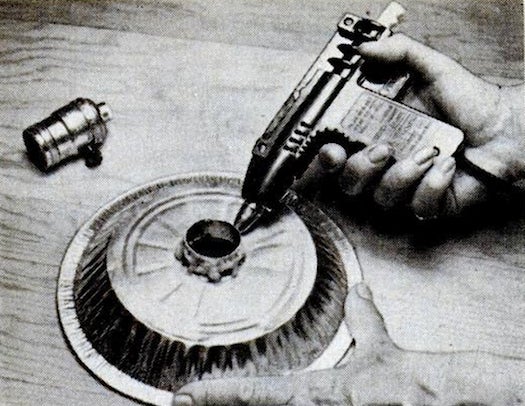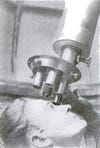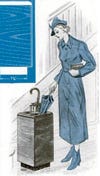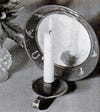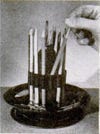Today is National Pie Day (the less-cool cousin of March 14’s Pi Day) and, to celebrate, we’ve compiled 10 fun and easy pie-tin crafts from the Popular Science archives.
What do a hipster chandelier, an amateur telescope, and a living-room jet engine have in common? You can make each one with an ordinary pie tin!
Click here to enter the gallery
Eyepiece Turret For Telescope, October 1933
“Every astronomer, whether amateur or professional, knows full well the inconvenience of having to change the eyepieces of the telescope whenever a different magnification is necessary to separate a double star or to reveal more clearly some detail on the moon or planets. A revolving eyepiece turret can easily be constructed to relieve the observer of the task… Many a lowly pyrex baking dish has been transformed into a telescope mirror, and now a second raid on the kitchenware solves the problem at the other end of the instrument, for the chief requirements for making such a turret as shown are two ordinary tin pie plates.” Read the rest of the story in the October 1933 issue of Popular Science.
Photo Flash Reflector: October 1969
“To make a flash reflector for photographic use from an aluminum-foil pie plate, just glue the socket-matching rim into a hole in the pie plate’s center as you see here. When working with thicker metal always preheat work, as metal conducts glue away too rapidly for good bond. You can also heat work after glue is applied, to flow it out for better grip.” Read the rest of the story in the October 1969 issue of Popular Science.
Chandelier: February 1950
“If you like to dine by candlelight, this chandelier will serve nicely. And you can buy all the parts in a dime store. Here they are: Two 9″ cake tins of different depths. Three 27″ flat curtain rods-the kind that telescope. Five 5″ pie tins. Five 4″ individual gelatin molds. One adjustable closet pole.” Read the rest of the story in the February 1950 issue of Popular Science.
Wooden Umbrella Stand: November 1937
“Neat modern lines and simplicity of construction are features of this compact umbrella stand. It holds four umbrellas, but may easily be enlarged or made smaller. A 7-in. pie plate is used to collect whatever water drips from the umbrellas. Although any suitable material may be used, plywood is recommended for the sides.” Read the rest of the story in the November 1937 issue of Popular Science.
Trouble Light: June 1955
“A metal pie pan mounted on a closet or basement wall will keep a trouble light handy for use when you need it. The bulb-guard hook is slipped through a hole punched in the rim, while the extension cord is wrapped neatly around the pan.” Read the rest of the story in the June 1955 issue of Popular Science.
Living-Room Jet Engine: October 1950
“With the help of a few small chunks of dry ice–usually obtainable from ice-cream manufacturers or dealers–you can quickly make a fascinating jet-propelled turbine… All you need for the turbine is a cardboard ice-cream or coffee container, a drinking straw, some sealing wax, and a small pie plate.” Read the rest of the story in the October 1950 issue of Popular Science.
Candle Sconce: May 1948
“There’s a touch of the old West about this candle sconce that makes it just right for a playroom, closed patio, or informal dining room. Little equipment or experience is needed to put together a pair. Soldering, so vital in most metalworking, is eliminated. As for materials, a ten-cent piepan and a tin can are the major items.” Read the rest of the story in the May 1948 issue of Popular Science.
Lazy-Susan Pencil Holder: December 1961
“A caddy for a drawing board is handier if it revolves to permit quick selection of pencils, brushes, erasers, thumb tacks, and other supplies. Bolt the bottoms of two pie plates together; don’t place washers between them–just a little grease or graphite. Draw up the first nut to a turning fit and lock it with the second. Center a beverage can on the top plate, and solder three or four partitions between the can and the rim. Crimp a tin-plate strip around a V4″ rod to form corrugations, and tack-solder this around the can.” Read the rest of the story in the December 1961 issue of Popular Science.
Wall Plaques: September 1947
“Painted pie tins decorated with interesting decals make attractive wall plaques. As craftwork projects, they’re just the thing for children who want to work alongside Dad on something of their own. The plaques shown here were ordinary tins from a dime store. Drill a hanging hole near each rim if the tins don’t already have them; then paint inside and out to avoid rust even though the inside will be against the wall. White or a pastel shade is best on the bottoms to serve as a background for the decals. Borders may be a contrasting color to harmonize with both the decals and the room. Take care to apply the decals so they will hang straight.” Read the rest of the story in the September 1947 issue of Popular Science.
Ceiling Light: May 1956
“Mixing bowl, pie tin and a tin can provided the curves, cylinder and truncated cone… for this hallway ceiling lamp.” Read the rest of the story in the May 1956 issue of Popular Science.
